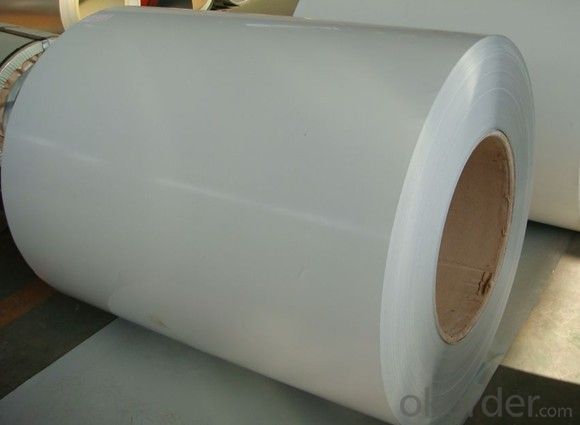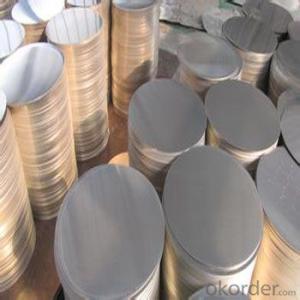Beveled Aluminum Skin Sheets - 8011 1235 3105 Aluminum Foil in Roll
- Loading Port:
- Shanghai
- Payment Terms:
- TT OR LC
- Min Order Qty:
- 5 m.t.
- Supply Capability:
- 9000 m.t./month
OKorder Service Pledge
OKorder Financial Service
You Might Also Like
Specification
Introduction of Aluminum Foil
Aluminum foil is aluminum prepared in thin metal leaves with a thickness less than 0.2 millimetres (8 mils); thinner gauges down to 6 micrometres (0.24 mil) are also commonly used. In the United States, foils are commonly gauged in thousandths of an inch or mils. Standard household foil is typically 0.016 mm (0.63 mil) thick, and heavy duty household foil is typically 0.024 mm (0.94 mil). The foil is pliable, and can be readily bent or wrapped around objects. Thin foils are fragile and are sometimes lamilated to other materials such as plastics or paper to make them more useful. Aluminum foil supplanted tin foil in the mid 20th century.
Annual production of aluminum foil was approximately 216,000 tonnes (216,000 tons) in LingFeng (our company) one year..Approximately 75% of aluminium foil is used for packaging of foods. household foil,container foil, cosmetics and pharmaceutcal foil etc, and 25% used for industrial applications (e.g. thermal insulation, cables and electronics).
Application of Aluminum Foil:Mainly used in package for food, drinking, cigarette, Pharmaceutical, photograph, daily necessities, power capacitor, construction, auto,boat, celling, lable, etc .
Quality of Aluminum Foil: Totally free from defects like white rust, oil patches, roll marks, edge damage, camber, dents, holes, break lines, scratches and free from coil set.
Chinese Standard of Aluminum Foil: ASTM-B209. EN573-1, GB/T3880.1-2006
Packing for Aluminum Foil: Seaworthy wooden case/box, or as your requirement. ID of aluminum foil roll: 76mm,152mm,200mm,300mm
Kind attention: Specifications can be customized as the customer’s requirements.

Specification of Aluminum Foil
| Alloy No. | Thickness (mm) | Width (mm) | Temper | |
| A1145,A1235,A8011 Household Foil | 0.005-0.2 | 20-1700 | O,H14,H18,H19,H24 | |
| A3003,A8011 Semi Rigid Container Foil | 0.005-0.2 | 20-1700 | O,H14,H18,H19,H24 | |
| A8011,A8021 Pharmaceutical Foil | 0.005-0.2 | 20-1700 | O,H14,H18,H19,H24 | |
| A8011 Foil Label | 0.005-0.2 | 20-1700 | O,H14,H18,H19,H24 | |
| A1145,A1100,A1235,A8001 Fexible Packing Foil | 0.005-0.2 | 20-1700 | O,H14,H18,H19,H24 | |


- Q: Can aluminum sheets be embossed or engraved?
- Yes, aluminum sheets can be embossed or engraved. Embossing involves creating a raised design or pattern on the surface of the aluminum sheet, while engraving involves cutting or etching a design into the surface. Both techniques can be used to add decorative or functional elements to aluminum sheets. Embossed or engraved aluminum sheets are commonly used in various industries including automotive, aerospace, signage, and architectural applications. The process of embossing or engraving aluminum sheets typically involves using specialized machinery or tools to create the desired design.
- Q: Can the aluminum sheets be used for manufacturing aircraft engine components?
- Indeed, the utilization of aluminum sheets is possible for the production of aircraft engine components. Due to its exceptional strength-to-weight ratio and resistance to corrosion, aluminum is extensively employed within the aerospace sector. Despite being lightweight, it possesses the necessary strength to endure the strains and elevated temperatures inherent in aircraft engines. Furthermore, aluminum sheets can be effortlessly fashioned, rendering them apt for the creation of intricate engine components. Taken together, the favorable mechanical properties and applicability to aerospace scenarios make aluminum sheets the preferred option for manufacturing aircraft engine components.
- Q: What are the different fabrication methods used for aluminum sheets?
- There are several different fabrication methods used for aluminum sheets, each with its own advantages and applications. Some of the most common methods include rolling, extrusion, casting, and stamping. Rolling is the most commonly used method and involves passing the aluminum through a series of rollers to reduce its thickness and create a flat sheet. This method allows for precise control over the thickness and shape of the sheet, making it ideal for a wide range of applications, from packaging to building materials. Extrusion is another popular method where heated aluminum is forced through a die to create a specific shape or profile. This method is commonly used for creating complex shapes such as tubes, rods, and channels. Extruded aluminum sheets offer high strength and durability, making them suitable for structural applications in industries like construction and automotive. Casting involves pouring molten aluminum into a mold and allowing it to solidify. This method is often used for creating intricate and detailed shapes that cannot be easily achieved through other methods. Casting can produce aluminum sheets with unique textures and designs, making them popular in decorative applications. Stamping is a method that uses a press to shape the aluminum sheet by applying pressure and forming it into a desired shape. This technique is commonly used for creating small, precise parts like brackets, connectors, and electrical components. Stamped aluminum sheets offer excellent dimensional accuracy and can be produced in high volumes at a relatively low cost. In addition to these methods, other fabrication techniques such as welding, bending, and laser cutting can be used to further process aluminum sheets and create custom shapes and designs. Overall, the choice of fabrication method for aluminum sheets depends on the desired application, required properties, and complexity of the desired shape. Each method offers unique advantages and capabilities, allowing for a wide range of possibilities in terms of aluminum sheet fabrication.
- Q: Are 101 aluminum sheets readily available in the market?
- Yes, 101 aluminum sheets are readily available in the market. These sheets are commonly used in various industries and applications due to their excellent corrosion resistance, high strength, and light weight. They can be easily found in metal supply stores, online marketplaces, and specialized aluminum suppliers. Additionally, 101 aluminum sheets are available in different sizes, thicknesses, and finishes, allowing customers to choose the most suitable option for their specific requirements.
- Q: What are the different methods of cutting aluminum sheet?
- Some of the different methods of cutting aluminum sheet include using shears, bandsaws, jigsaws, circular saws, laser cutting, and waterjet cutting.
- Q: How much weight/people can a 12ft aluminum boat hold?and if anyone knows how much weight can a 6.5hp motor push around
- 12 Ft Aluminum Jon Boat
- Q: Are aluminum sheets suitable for marine hulls?
- Yes, aluminum sheets are suitable for marine hulls. Aluminum is a popular choice for boat construction due to its many advantageous properties. Aluminum is lightweight, which allows for better fuel efficiency and increased speed. It is also highly resistant to corrosion, making it ideal for prolonged exposure to saltwater. Additionally, aluminum offers excellent strength and durability, ensuring the structural integrity of the hull. Moreover, aluminum can be easily formed into intricate shapes, allowing for innovative hull designs. Overall, aluminum sheets are a reliable and efficient choice for marine hulls, providing a strong and corrosion-resistant structure that enhances the performance and lifespan of the boat.
- Q: What is the typical lead time for ordering aluminum sheets?
- The lead time for ordering aluminum sheets can vary depending on factors such as the supplier, quantity of sheets ordered, and demand for aluminum. Generally, lead times can range from a few days to several weeks. If you are looking for standard-sized aluminum sheets that are readily available, the lead time is usually shorter, typically ranging from a few days to a week. Suppliers have these common sizes in stock and can ship them quickly. However, if you need custom-sized sheets or a large quantity that is not readily available, the lead time may be longer. In these cases, the supplier may need to source the aluminum, cut it to size, and process any necessary treatments or finishes. This process can take several weeks, especially if the supplier has a high volume of orders or if the aluminum needs to be imported. To determine the specific lead time for your order, it is important to communicate with the supplier. They can provide an estimated timeframe based on their production capacity, stock availability, and other factors that may affect the lead time.
- Q: What rules or guidelines exist for using recycled aluminum sheets in construction projects?
- <p>Yes, there are regulations and guidelines regarding the use of recycled aluminum sheets in construction. These often include standards for material quality, safety, and environmental impact. The American Society for Testing and Materials (ASTM) and the Aluminum Association provide specifications for recycled aluminum alloys used in construction. Compliance with building codes and local regulations is essential. Additionally, recycled aluminum must meet performance and safety standards equivalent to those of new materials. It's crucial to check with local building authorities and consult the latest industry standards to ensure compliance when using recycled aluminum in construction.</p>
- Q: What are the applications of aluminum sheet?
- Aluminum sheets have a wide range of applications due to their unique properties and versatility. Some of the common applications of aluminum sheets include: 1. Construction: Aluminum sheets are widely used in the construction industry for roofing, siding, and cladding purposes. Their lightweight nature makes them easy to handle and install, while their corrosion resistance ensures long-lasting durability. 2. Transportation: Aluminum sheets are extensively used in the automotive industry for manufacturing vehicle bodies, panels, and structural components. Their high strength-to-weight ratio helps reduce the overall weight of vehicles, increasing fuel efficiency and improving performance. 3. Packaging: Aluminum sheets are commonly used in the packaging industry for manufacturing cans, foils, and containers. Aluminum foils are used for food packaging, as they provide a barrier against moisture, light, and oxygen, ensuring the freshness and safety of the packaged products. 4. Electrical: Aluminum sheets are used in the electrical industry for manufacturing power transmission lines, busbars, and electrical enclosures. Their excellent electrical conductivity helps in the efficient transmission of electricity, while their corrosion resistance ensures longevity in outdoor applications. 5. Marine: Aluminum sheets are widely used in the marine industry for manufacturing boat hulls, decks, and superstructures. Their resistance to corrosion from saltwater makes them ideal for marine applications, while their lightweight nature helps reduce the overall weight of the vessel. 6. Aerospace: Aluminum sheets are extensively used in the aerospace industry for manufacturing aircraft and spacecraft components. Their high strength-to-weight ratio and excellent thermal conductivity make them suitable for applications where weight reduction and heat dissipation are critical. 7. Heat exchangers: Aluminum sheets are used in the manufacturing of heat exchangers, such as radiators and condensers. Their high thermal conductivity allows for efficient heat transfer, making them ideal for applications where heat exchange is required. 8. Decorative: Aluminum sheets are commonly used in interior design and architectural applications for decorative purposes. They can be easily shaped, bent, and formed into various designs, adding a modern and aesthetic appeal to buildings and interiors. Overall, aluminum sheets find applications in various industries due to their lightweight nature, corrosion resistance, high strength-to-weight ratio, and excellent thermal conductivity.
Send your message to us
Beveled Aluminum Skin Sheets - 8011 1235 3105 Aluminum Foil in Roll
- Loading Port:
- Shanghai
- Payment Terms:
- TT OR LC
- Min Order Qty:
- 5 m.t.
- Supply Capability:
- 9000 m.t./month
OKorder Service Pledge
OKorder Financial Service
Similar products
Hot products
Hot Searches
Related keywords




























